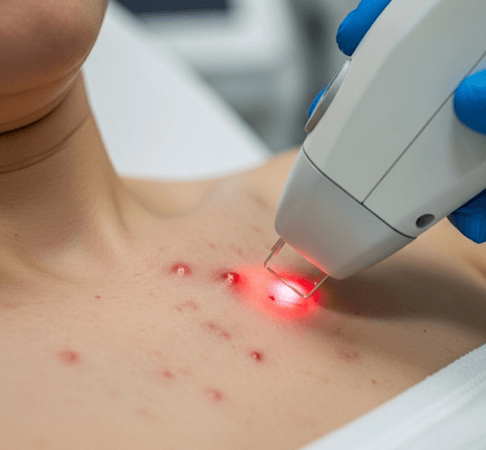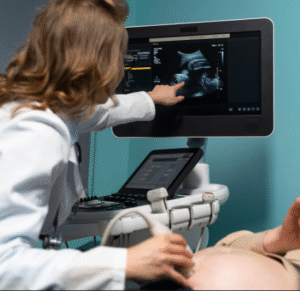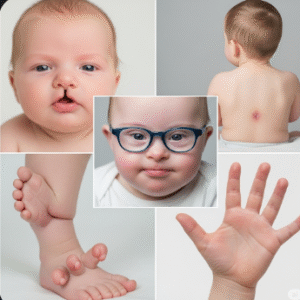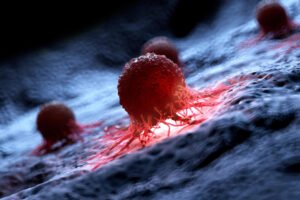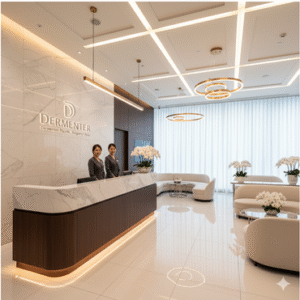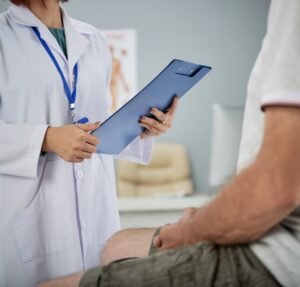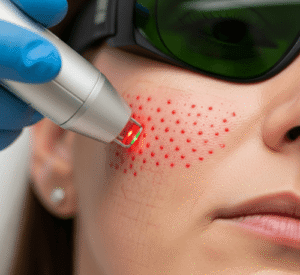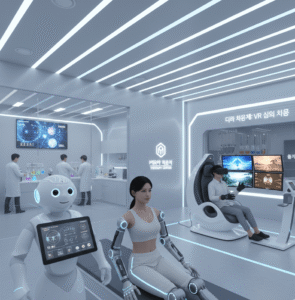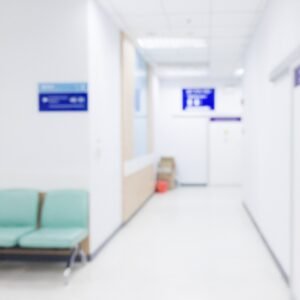What it is
Chest acne laser treatment is a non-invasive dermatological procedure that uses focused laser energy to target acne-causing bacteria, reduce excess sebum production, and stimulate skin healing on the chest area.
Unlike topical creams or oral medications that work slowly or may cause side effects, laser treatment directly penetrates the skin layers to address the root cause of acne.
This procedure is designed to treat not only active acne lesions but also to reduce the redness, inflammation, and scars that chest acne often leaves behind.
In Korea, where advanced dermatology is highly developed, laser technology is continuously optimized to provide precise, safe, and effective results with minimal downtime.
Why it’s done
Chest acne is particularly frustrating because:
→ It can be persistent and resistant to common treatments such as cleansers or over-the-counter creams.
→ The chest area is prone to friction, sweat, and clogged pores, making breakouts frequent.
→ Many people develop post-acne scars and pigmentation, which are difficult to treat without professional help.
→ Acne on visible areas like the chest can affect self-confidence in social situations, especially in warmer climates or when wearing certain outfits.
Laser treatment is chosen when:
- Acne is chronic, moderate to severe, and doesn’t respond well to topical or oral therapies.
- Patients want faster, more noticeable results compared to traditional methods.
- There is a need to prevent long-term scarring or treat existing scars along with active acne.
Alternatives
Although laser treatment is highly effective, there are several alternative options for managing chest acne:
➡ Topical therapies: Benzoyl peroxide, retinoids, or salicylic acid can reduce inflammation; but they may take months to show results.
➡ Oral medications: Antibiotics or isotretinoin (Accutane) may be prescribed for severe cases; though they carry risks of side effects.
➡ Chemical peels: Mild to medium-strength peels help exfoliate and unclog pores; but may not penetrate deep enough for resistant acne.
➡ Light-based therapies: Blue light or photodynamic therapy can target bacteria; but are generally less powerful than lasers.
➡ Lifestyle modifications: Wearing breathable fabrics, practicing good hygiene, and dietary adjustments may help; but usually need to be combined with professional care.
Laser treatment often becomes the preferred choice when these alternatives are not effective enough, or when quicker improvement is desired.
Preparation
Before undergoing chest acne laser treatment, proper preparation ensures safety and effectiveness:
→ Dermatological consultation: The skin specialist evaluates acne severity, skin type, and medical history.
→ Avoid sun exposure: Patients are advised to limit direct sunlight for at least 2 weeks before treatment, as tanned or sunburned skin is more prone to complications.
→ Stop certain skincare products: Retinoids, harsh scrubs, or chemical exfoliants should be avoided for 7–10 days prior.
→ Discontinue blood-thinning medication: If medically safe, patients may be asked to pause aspirin or similar medications to reduce bruising risk.
→ Clean treatment area: On the day of the procedure, the chest should be free from lotions, perfumes, or creams.
Preparation is straightforward but crucial, as it minimizes the risk of irritation and maximizes the impact of the laser session.
How it’s Done
The procedure is typically completed in under an hour, depending on the size of the treatment area.
Steps include:
- Cleansing the skin → The chest area is gently cleaned to remove oil, sweat, or debris.
- Application of numbing cream → A topical anesthetic is applied for 20–30 minutes to ensure patient comfort.
- Laser application → The dermatologist uses a specialized acne laser, often a Nd:YAG, CO₂ fractional, or pulsed-dye laser, depending on the condition.
- The laser light penetrates the skin, targeting sebaceous glands to reduce oil production.
- It also destroys acne-causing bacteria (Propionibacterium acnes).
- Heat from the laser stimulates collagen regeneration, which helps improve scarring.
- Cooling process → A cooling device or cold air stream is often used to minimize heat sensation.
- Post-treatment care → A soothing cream or cooling gel is applied to calm the skin.
Most patients describe the sensation as a mild snapping or warmth, tolerable with numbing cream.
Recovery
Recovery after chest acne laser treatment is usually quick and manageable:
→ Mild redness and swelling may appear for 24–48 hours.
→ Skin sensitivity to sunlight is common, so sunscreen and protective clothing are strongly recommended.
→ Patients can usually resume normal activities immediately; but should avoid hot showers, saunas, and intense workouts for 1–2 days.
→ Visible improvement often starts after 2–3 sessions, though optimal results usually require 4–6 treatments spaced 2–4 weeks apart.
→ The final outcome includes fewer breakouts, smoother skin texture, and reduced scars.
Recovery is generally uncomplicated, making it appealing compared to systemic medications that have longer-lasting side effects.
Complications
While laser treatment is considered safe, some possible complications may occur, especially if aftercare is not followed:
→ Temporary redness and swelling → Most common and short-lived.
→ Hyperpigmentation or hypopigmentation → More likely in darker skin tones; but minimized with proper laser selection.
→ Mild skin peeling → Normal part of healing, resolves within days.
→ Rare blistering or scarring → Usually preventable under experienced dermatologists.
→ Sensitivity or discomfort → Minor but manageable with soothing creams.
When performed in a professional clinic, the risks are minimal, and most patients tolerate the procedure well.
Treatment option in Korea
Korea is renowned for its cutting-edge dermatology and offers some of the most advanced laser treatments for chest acne:
➡ Fractional CO₂ laser: Highly effective for acne scars, promoting skin regeneration and smooth texture.
➡ Nd:YAG laser: Targets deeper sebaceous glands to reduce oil production and bacterial activity.
➡ Pulsed-dye laser (PDL): Best for treating redness and inflamed acne lesions.
➡ Dual-combination therapies: Many Korean clinics combine laser + light therapy + skincare regimens for enhanced results.
➡ Integrated dermatology programs: Korean clinics often include aftercare facials, soothing masks, and customized home-care products, ensuring long-term benefits.
➡ Focus on minimal downtime: Treatments are designed to be fast, effective, and compatible with busy lifestyles.
Korea’s dermatology industry is highly competitive, leading to constant innovation and patient-focused solutions. The reputation of Korean skin clinics for precision, safety, and natural results makes them a global leader in chest acne treatment.

